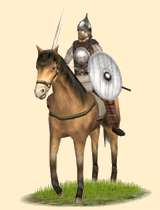Marxolitho Wolxiskod (Celto-Germanic Cavalry)
 |
Weapons | Defence | Mental | ||||||
|---|---|---|---|---|---|---|---|---|---|
| Primary | Secondary | Armour: | 8 | Morale: | 13 | ||||
| Type: | spear | sword | Shield: | 2 | Discipline: | disciplined | |||
| Attack: | 6 | 9 | Skill: | 10 | Training: | trained | |||
| Charge: | 15 | 15 | Recruitment | Other | |||||
| Lethality: | 1 | 0.225 | Soldiers: | 25 | Hit Points: | 1 | |||
| Range: | 35 | 0 | Cost: | 2867 | Mass: | 1 | |||
| Ammo: | 4 | 0 | Upkeep: | 717 | |||||
| Turns: | 1 | ||||||||

Celto-Germanic Cavalry are an effective medium cavalry, drawn primarily from Germanic horsemen who have migrated into Celtic areas, and their descendents.
Superior
Disciplined
Hardy
Marχo-liþo Wolχiskod
(MAR-kho-LI-tho WOL-khi-skod, "East Celt Warhorse-Troop")
The Marxolitho Wolxiskod are an effective medium cavalry, drawn primarily from Germanic horsemen who have migrated into Celtic areas, and their descendents. They are bold horsemen, with skill in both skirmishing and melee, and are more heavily armored than their counterparts to the north, having benefited from their exposure to, and intermingling with, the cavalry contingents of subjugated and allied Celtic nations. With a simple breastplate and helmet enhancing their fierceness, they have staying power in melee against most other regular cavalry, but their javelins enable them to skirmish as well. They are best used to secure dominance in pre-battle skirmishing and on the flanks, before being used to break up weakened enemy formations.
Historically, the cavalry of the Boii, Pannonians, and Noricenes were slightly more heavily armored than most of their Germanic counterparts. Grave finds and depictions in art give us some idea of the sort of weapons they carried: simple breastplates and a variety of helmet types were the order of the day. When the Cimbri and Teutons migrated into the lands of the Volcae (the origin of the Germanic term for Celt- 'Welsh') and Boii, they allied with some of those East Celts and defeated others. When their armies eventually encountered the Romans, the description of their cavalry passed on through Roman history describes the material influence of the East Celts on the migrating Germanic tribes. If a Swēbōzez war-leader can lead his warriors into the lands of the powerful eastern Celtic kingdoms, his own knightly warriors, the knightly aristocracy of the defeated Celts, and the descendants of both, can combine to form an effective cavalry force.